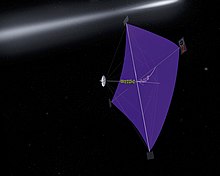Sail configurations

IKAROS, launched in 2010, was the first practical solar sail vehicle. As of 2015, it was still under thrust, proving the practicality of a solar sail for long-duration missions. It is spin-deployed, with tip-masses in the corners of its square sail. The sail is made of thin polyimide film, coated with evaporated aluminium. It steers with electrically-controlled liquid crystal panels. The sail slowly spins, and these panels turn on and off to control the attitude of the vehicle. When on, they diffuse light, reducing the momentum transfer to that part of the sail. When off, the sail reflects more light, transferring more momentum. In that way, they turn the sail. Thin-film solar cells are also integrated into the sail, powering the spacecraft. The design is very reliable, because spin deployment, which is preferable for large sails, simplified the mechanisms to unfold the sail and the LCD panels have no moving parts.
Parachutes have very low mass, but a parachute is not a workable configuration for a solar sail. Analysis shows that a parachute configuration would collapse from the forces exerted by shroud lines, since radiation pressure does not behave like aerodynamic pressure, and would not act to keep the parachute open.
The highest thrust-to-mass designs for ground-assembled deploy-able structures are square sails with the masts and guy lines on the dark side of the sail. Usually there are four masts that spread the corners of the sail, and a mast in the center to hold guy-wires. One of the largest advantages is that there are no hot spots in the rigging from wrinkling or bagging, and the sail protects the structure from the Sun. This form can, therefore, go close to the Sun for maximum thrust. Most designs steer with small moving sails on the ends of the spars.
In the 1970s JPL studied many rotating blade and ring sails for a mission to rendezvous with Halley's Comet. The intention was to stiffen the structures using angular momentum, eliminating the need for struts, and saving mass. In all cases, surprisingly large amounts of tensile strength were needed to cope with dynamic loads. Weaker sails would ripple or oscillate when the sail's attitude changed, and the oscillations would add and cause structural failure. The difference in the thrust-to-mass ratio between practical designs was almost nil, and the static designs were easier to control.
JPL's reference design was called the "heliogyro". It had plastic-film blades deployed from rollers and held out by centrifugal forces as it rotated. The spacecraft's attitude and direction were to be completely controlled by changing the angle of the blades in various ways, similar to the cyclic and collective pitch of a helicopter. Although the design had no mass advantage over a square sail, it remained attractive because the method of deploying the sail was simpler than a strut-based design. The CubeSail (UltraSail) is an active project aiming to deploy a heliogyro sail.
Heliogyro design is similar to the blades on a helicopter. The design is faster to manufacture due to lightweight centrifugal stiffening of sails. Also, they are highly efficient in cost and velocity because the blades are lightweight and long. Unlike the square and spinning disk designs, heliogyro is easier to deploy because the blades are compacted on a reel. The blades roll out when they are deploying after the ejection from the spacecraft. As the heliogyro travels through space the system spins around because of the centrifugal acceleration. Finally, payloads for the space flights are placed in the center of gravity to even out the distribution of weight to ensure stable flight.
JPL also investigated "ring sails" (Spinning Disk Sail in the above diagram), panels attached to the edge of a rotating spacecraft. The panels would have slight gaps, about one to five percent of the total area. Lines would connect the edge of one sail to the other. Masses in the middles of these lines would pull the sails taut against the coning caused by the radiation pressure. JPL researchers said that this might be an attractive sail design for large manned structures. The inner ring, in particular, might be made to have artificial gravity roughly equal to the gravity on the surface of Mars.
A solar sail can serve a dual function as a high-gain antenna. Designs differ, but most modify the metalization pattern to create a holographic monochromatic lens or mirror in the radio frequencies of interest, including visible light.
Comments
Post a Comment